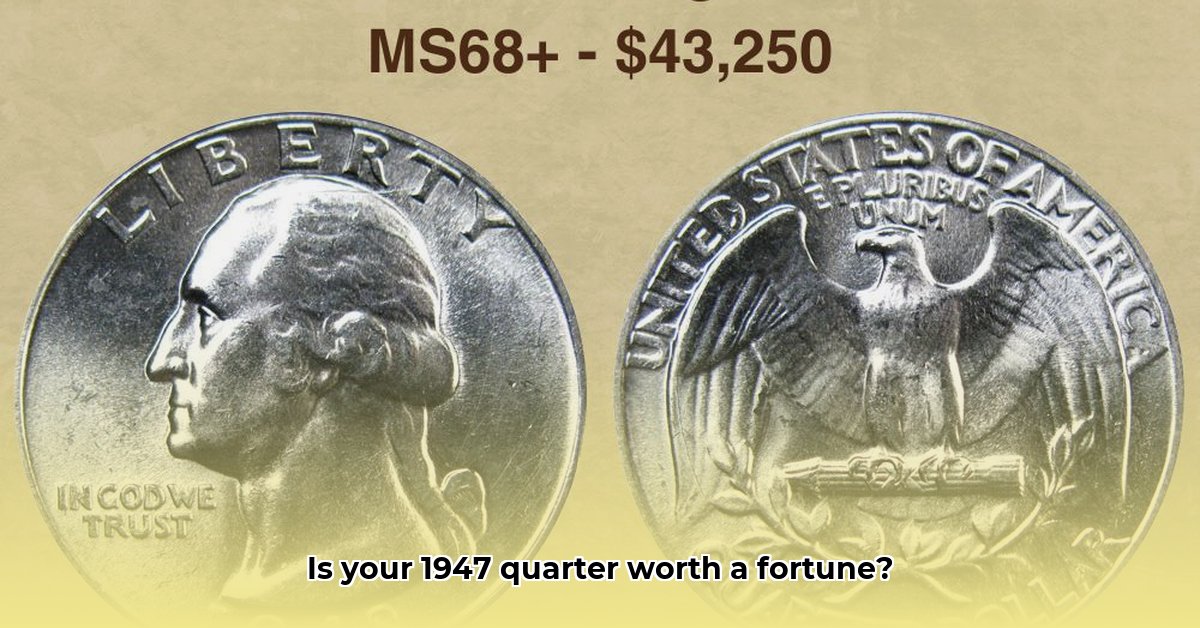
Ever wonder about the hidden value in your coin jar? This guide helps you determine the worth of your 1947 silver quarter. We'll cover crucial factors like coin condition, mint marks, and current market trends, empowering you to assess your quarter's potential value. For more coin valuation information, check out this helpful resource on 1997-D Nickel Values.
Understanding 1947 Silver Quarter Value
The value of your 1947 silver quarter isn't solely determined by the year; it's a multifaceted assessment based on its condition and origin. Two key aspects significantly impact its worth: its condition (how well-preserved it is) and its mint mark (a small letter indicating its place of minting).
Condition: A Coin's Story
A coin's condition reflects its history. A pristine, uncirculated coin is far more valuable than a worn, heavily circulated one. Professional grading services, such as PCGS and NGC, utilize standardized numerical scales (typically 1 to 70) to assess condition. Terms like "uncirculated" (for mint-fresh coins) and "good" (for significantly worn coins) are commonly used. The better the condition, the higher the value, simply because fewer coins survive in pristine shapes. Isn't it fascinating how a coin’s condition tells its unique story?
Mint Marks: Location, Location, Location
Each 1947 quarter features a tiny letter – the mint mark – indicating its origin: 'P' for Philadelphia, 'D' for Denver, or 'S' for San Francisco. This seemingly insignificant detail greatly influences value. Denver and San Francisco mint marks often command higher prices due to lower mintage numbers compared to Philadelphia. This parallels real estate; a rare location increases demand and, subsequently, price.
Determining Your Quarter's Value: A Step-by-Step Guide
Ready to unlock your quarter's potential? Follow these actionable steps:
Close Examination: Carefully inspect your quarter. Note any scratches, dents, wear, or imperfections. Online resources and coin guides provide valuable visual aids for condition assessment. Some websites even allow direct visual comparison to determine the closest condition match.
Mint Mark Identification: Locate the tiny letter (the mint mark) on the reverse of your quarter (the tails side). This seemingly small detail can significantly impact value.
Consult Expert Resources: Utilising reputable online resources and coin pricing guides helps determine current market values for similar coins. Remember, however, prices constantly fluctuate due to market forces. Online coin appraisal tools can also be helpful, but professional appraisal is always recommended for high-value coins.
Estimated Value Ranges (Approximate)
The following table provides estimated value ranges. Remember, these are approximations, and actual values can vary significantly based on numerous factors beyond condition and mint mark. Market trends and current demand heavily influence pricing.
| Condition | 'P' Mint Mark (USD) | 'D' Mint Mark (USD) | 'S' Mint Mark (USD) |
|---|---|---|---|
| Good | $5 - $8 | $10 - $15 | $15 - $20 |
| Very Good | $8 - $12 | $15 - $25 | $25 - $35 |
| Fine | $12 - $18 | $25 - $40 | $40 - $60 |
| Very Fine | $18 - $25 | $40 - $60 | $60 - $80 |
| Extremely Fine | $25 - $40 | $60 - $90 | $80 - $120 |
| About Uncirculated | $40 - $60 | $90 - $150 | $120 - $200 |
| Uncirculated | $60+ | $150+ | $200+ |
For a precise valuation, especially for higher-value coins, consider professional coin appraisal. Experts offer knowledgeable assessment and authentication.
Beyond the Basics: Additional Value Factors
While condition and mint mark are primary factors, other elements impact a 1947 silver quarter's value:
Silver Content: The coin's 90% silver content provides inherent value, influenced by fluctuating silver market prices.
Rarity and Errors: Certain 1947 quarters are rarer than others. Coins with unique characteristics or minting errors hold significant collector value.
Market Demand: Collector interest and overall market trends heavily influence pricing.
By understanding these factors, you're well-equipped to assess your 1947 silver quarter's value. Happy collecting!